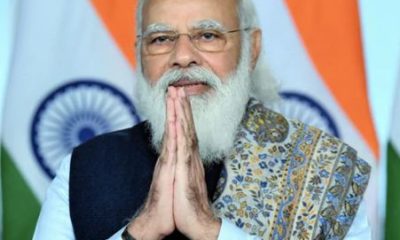Top News
Zika heads for India, older strain lurks since 1952
 A virulent version of the Zika virus that has swept the globe is headed for India, where an older, more benign strain is likely to be quietly residing within some Indians, possibly preparing genetic ground for a quick, new second-coming, experts have warned.
A virulent version of the Zika virus that has swept the globe is headed for India, where an older, more benign strain is likely to be quietly residing within some Indians, possibly preparing genetic ground for a quick, new second-coming, experts have warned.
In India, the Zika virus — which has no cure or vaccine — was first found in Pune 64 years ago, as part of a survey that was testing immunity to Japanese and Russian varieties of a virus-borne brain infection called encephalitis, according to a forthcoming paper authored by World Health Organization (WHO) scientists.
The paper comes soon after a study in Lancet which used travel patterns to predict that India — where more than 67,000 air travellers arrive every year — and four other countries (China, Philippines, Indonesia and Thailand) were most at risk for year-round transmission of the Zika virus. China has more people, but more people are at risk in India.
A virus that hasn’t been particularly dangerous since it was first discovered in a rhesus monkey in Uganda’s Zika forest in 1947 (the first human case was reported in Nigeria seven years later), Zika has grabbed global attention because the virulent form — more than a million infections have been reported from Brazil — is linked to microcephaly, abnormally small heads and brains in foetuses.
After first emerging on a remote Pacific island in 2007, the new strain, borne by the female Aedes mosquitoes and air travel, and detected in Brazil in May 2015, has swept through 26 countries in the Americas, Cape Verde in Africa and Singapore, where 200 infections were reported within eight days. Currently, 58 countries and territories are affected by the Zika virus, according to the Centers for Disease Control and Prevention (CDC).
On September 5, 2016, the Philippines confirmed its first Zika infection.
“The original African strain went to Asia between 1954 and 2000, that did not cause microcephaly,” Peter Hotez, the dean of the National School of Tropical Medicine, at Baylor College of Medicine in Houston, told IndiaSpend via email, explaining Zika’s march.
“The shift to the pandemic strain happened in 2007 to Micronesia and in 2013 to French Polynesia. This is sometimes called the Asian strain, which went Eastward into the New World. Now the Asian ?strain is headed to Africa continuing East back to India.”
Despite email requests over a week, the National Centre for Disease Control, the National Institute of Virology (NIV), and the Integrated Disease Surveillance Program (IDSP) did not respond to requests for comment on the possible entry of Zika into India.
India does not know if the strain detected in Pune in 1952 has spread and if it has made Indians more susceptible.
How Zika marched across the world
After Zika was detected in humans in 1954 in Nigeria, serologic evidence-evidence from blood serum-of human infection was reported from at least seven African countries and parts of Asia, including India, Malaysia, the Philippines, Thailand, Vietnam, and Indonesia, between 1951 and 1981.
Between 2007 and 2014, it caused, as Prof Hotez put it, “explosive” outbreaks in Micronesia, French Polynesia, and Easter Island-South Pacific.
Then, in May 2015, a Brazilian national laboratory reported a native-or local-case of transmission.
“A new mosquito-borne disease had indeed arrived in the Americas, though no one knew what that might mean,” said a WHO May 2016 report: One year into the Zika outbreak: How an obscure disease became a global health emergency.
By mid-July, 2015, Brazil notified WHO of a spike in neurological disorders-swelling of brain and spinal cord, GBS and microcephaly.
Since its entry into Brazil, according to the review paper, Zika cut a swath through 26 countries in the Americas.
On February 1, 2016, WHO declared Zika a “public health emergency of international concern”, requiring a coordinated international response.
Why India is at risk
India contains Zika’s “disease ecology” — Aedes aegypti and Aedes albopictus mosquitoes, crowding, poverty, lack of sanitation and hygiene, travellers and visitors and warming that prolongs mosquito season. It will only take an infected person to travel to India and then be bitten by the tiger mosquito.
Aedes aegypti is now found mainly in homes and other buildings, protected from monsoon winds and other factors that slowed its spread when it was a forest-dwelling creature. It is active during the day, and it is a master of evolution.
Between 5-20 per cent of a mosquito population’s collective genome — the collection of their genes — is responding to evolutionary pressure at any given time, according to a June 2015 study published in the Proceedings of the Royal Society B.
For India to be affected by the virus, it would need large populations of susceptible people living in close proximity to large populations of Aedes aegypti or Aedes albopictus mosquitoes.
Aedes aegypti and dengue are prevalent wherever there has been a Zika outbreak in the Western hemisphere. Indonesia and India are currently experiencing the worst dengue problems in the world, said Hotez.
“Based on that assumption, India is at risk,” he said. In India’s case, though, there are some big unknowns.
First, how widespread was the earlier African strain reported in India during the 1950s, and how exposed was India’s population to that first wave?
“That earlier strain does not cause microcephaly but could possibly induce immunity to this new more concerning virus strain,” said Hotez. India needs more studies to find out.
Second, could the new pandemic Zika strain affect India, as it is currently Singapore?
“We have seen that wherever dengue occurs in Western Hemisphere, we can find Zika as well,” said Hotez. “But we don’t know if that’s just because both viruses are transmitted by Aedes aegypti, or if previous dengue infections can also promote increased susceptibility to Zika.”
Since the symptoms of dengue, chikungunya and Zika virus infections are similar, and only laboratory tests can distinguish one from the other, it is possible that cases clinically diagnosed as dengue or chikungunya fevers could be Zika infections.
The question is this: Has Zika not been present in India or has no one looked over the past 40 years?
Chinkungunya wasn’t supposed to be in India; then it showed up
Zika’s cousin, chikungunya, first had a major outbreak across India-barring Kerala which had no Aedes aegypti mosquitoes then-between 1964 and 1967.
Chikungunya faded from public and scientific memory, and when it returned in 2002, “we were caught with our collective pants down”, said T Jacob John, a retired virologist who, along with two colleagues, documented India’s first HIV infection in 1986, and designed a national response.
Biological events are unpredictable, but government responses should not be.
However, said John, “civilized countries would err on the precautionary side rather than relying on luck as we Indians often do”.
(In arrangement with IndiaSpend.org, a data-driven, non-profit, public interest journalism platform. G.B.S.N.P. Varma is a freelance journalist based in Andhra Pradesh. The views expressed are those of IndiaSpend. Feedback at [email protected])
Top News
Dr. Abhishek Verma Dedicates a Shelter in Memory of His Mother, Veena Verma, at KGMU; Inaugurated by Daughter Nicolle Verma

World-renowned business tycoon Dr. Abhishek Verma has supported Foodman Vishal Singh’s Hunger-Free World mission. In memory of his mother, Late Veena Verma, who was a 3 term Rajya Sabha MP.
Dr. Verma dedicated a state-of-the-art free permanent shelter for the attendants of patients at KGMU Medical University, Lucknow, under the aegis of Vijay Shree Foundation. His daughter, Nicolle Verma, inaugurated the shelter.

During the event, Foodman Vishal Singh honored Nicolle Verma by presenting her with a memento. Mrs. Nidhi Sharma and Avantika Yadav, associated with the organization, welcomed her with garlands. Following this, Nicolle Verma distributed essential items to the attendants and also handed out fruits. She became emotional remembering her grandmother on her birth anniversary.
On this occasion, she also inaugurated the “Veena Verma Sevalaya” in memory of her grandmother, Veena Verma, to serve the attendants. She expressed, “I feel proud that my family is engaged in nation-building as well as social service. Today, in collaboration with Vijay Shree Foundation founder Foodman Vishal Singh Ji, I feel immensely proud to dedicate this shelter for the poor, helpless, and needy attendants of patients battling serious illnesses like cancer. I am honored to be associated with the Hunger-Free World Mission for humanity.”

Inspired by the continuous humanitarian service provided by Vijay Shree Foundation over the past 17 years, Nicolle Verma donated 10 lakh rupees to support the cause. The purpose of this donation is to ensure that services continue for the needy attendants of patients suffering from severe illnesses in hospitals, as facilitated by Foodman Vishal Singh.
It is noteworthy that Dr. Abhishek Verma’s family has a legacy of public and philanthropic service. They are helping millions to carry forward the values and service work of their parents. On the occasion of his mother’s birth anniversary, Dr. Abhishek Verma dedicated this state-of-the-art permanent shelter at Lucknow Medical College to serve the attendants of patients through the Vijay Shree Foundation.

Supporting Foodman Vishal Singh’s Hunger-Free World mission, Dr. Abhishek Verma assured that he would continually support keeping this flame of humanity alive. He also promised to assist in providing medicines to the helpless patients.
Continuing her grandmother’s legacy of service, Nicolle Verma personally served food to the needy patients and attendants. She said, “It is our good fortune to have received the joy of doing this noble work today through Foodman Vishal Singh. I have taken another step forward in carrying my family’s values and cooperation by joining hands with the Vijay Shree Foundation. My father taught me to serve and help the needy, and I feel happy when I bring a smile to someone’s face.”

On the birth anniversary of the late Veena Verma, the event organizer, Vijay Shree Foundation founder Foodman Vishal Singh, said, “We feel proud and happy that Dr. Abhishek Verma, a globally renowned business tycoon, has extended his support to uplift our country from the hunger index. Today, on his mother’s birth anniversary, he inaugurated a state-of-the-art permanent shelter at Lucknow Medical College, which will always be helpful for the needy attendants of patients. It is a pleasure for me and the organization to receive the affection of Mr. Verma.”
The event was attended by General Manager Verma Family Office Hemant Garg, Sonu Rajput, and the organization’s volunteers, including Sandeep Singh, Parmeshwar Ji, Prashant Rao Gautam, Balram Singh, Ramesh Chaudhary, Suman, Jeetu, Anil, Suraj, Vinay, Manish Bhadauria, Manas Mehrotra, Vivek, Apurv, Happy, and others.























